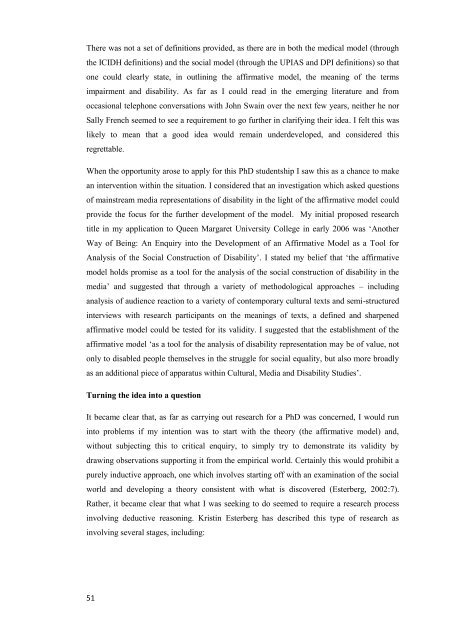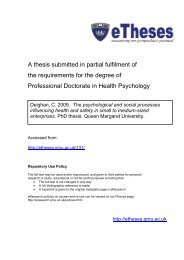A thesis submitted in partial fulfilment of - Etheses - Queen Margaret ...
A thesis submitted in partial fulfilment of - Etheses - Queen Margaret ...
A thesis submitted in partial fulfilment of - Etheses - Queen Margaret ...
You also want an ePaper? Increase the reach of your titles
YUMPU automatically turns print PDFs into web optimized ePapers that Google loves.
There was not a set <strong>of</strong> def<strong>in</strong>itions provided, as there are <strong>in</strong> both the medical model (through<br />
the ICIDH def<strong>in</strong>itions) and the social model (through the UPIAS and DPI def<strong>in</strong>itions) so that<br />
one could clearly state, <strong>in</strong> outl<strong>in</strong><strong>in</strong>g the affirmative model, the mean<strong>in</strong>g <strong>of</strong> the terms<br />
impairment and disability. As far as I could read <strong>in</strong> the emerg<strong>in</strong>g literature and from<br />
occasional telephone conversations with John Swa<strong>in</strong> over the next few years, neither he nor<br />
Sally French seemed to see a requirement to go further <strong>in</strong> clarify<strong>in</strong>g their idea. I felt this was<br />
likely to mean that a good idea would rema<strong>in</strong> underdeveloped, and considered this<br />
regrettable.<br />
When the opportunity arose to apply for this PhD studentship I saw this as a chance to make<br />
an <strong>in</strong>tervention with<strong>in</strong> the situation. I considered that an <strong>in</strong>vestigation which asked questions<br />
<strong>of</strong> ma<strong>in</strong>stream media representations <strong>of</strong> disability <strong>in</strong> the light <strong>of</strong> the affirmative model could<br />
provide the focus for the further development <strong>of</strong> the model. My <strong>in</strong>itial proposed research<br />
title <strong>in</strong> my application to <strong>Queen</strong> <strong>Margaret</strong> University College <strong>in</strong> early 2006 was „Another<br />
Way <strong>of</strong> Be<strong>in</strong>g: An Enquiry <strong>in</strong>to the Development <strong>of</strong> an Affirmative Model as a Tool for<br />
Analysis <strong>of</strong> the Social Construction <strong>of</strong> Disability‟. I stated my belief that „the affirmative<br />
model holds promise as a tool for the analysis <strong>of</strong> the social construction <strong>of</strong> disability <strong>in</strong> the<br />
media‟ and suggested that through a variety <strong>of</strong> methodological approaches – <strong>in</strong>clud<strong>in</strong>g<br />
analysis <strong>of</strong> audience reaction to a variety <strong>of</strong> contemporary cultural texts and semi-structured<br />
<strong>in</strong>terviews with research participants on the mean<strong>in</strong>gs <strong>of</strong> texts, a def<strong>in</strong>ed and sharpened<br />
affirmative model could be tested for its validity. I suggested that the establishment <strong>of</strong> the<br />
affirmative model „as a tool for the analysis <strong>of</strong> disability representation may be <strong>of</strong> value, not<br />
only to disabled people themselves <strong>in</strong> the struggle for social equality, but also more broadly<br />
as an additional piece <strong>of</strong> apparatus with<strong>in</strong> Cultural, Media and Disability Studies‟.<br />
Turn<strong>in</strong>g the idea <strong>in</strong>to a question<br />
It became clear that, as far as carry<strong>in</strong>g out research for a PhD was concerned, I would run<br />
<strong>in</strong>to problems if my <strong>in</strong>tention was to start with the theory (the affirmative model) and,<br />
without subject<strong>in</strong>g this to critical enquiry, to simply try to demonstrate its validity by<br />
draw<strong>in</strong>g observations support<strong>in</strong>g it from the empirical world. Certa<strong>in</strong>ly this would prohibit a<br />
purely <strong>in</strong>ductive approach, one which <strong>in</strong>volves start<strong>in</strong>g <strong>of</strong>f with an exam<strong>in</strong>ation <strong>of</strong> the social<br />
world and develop<strong>in</strong>g a theory consistent with what is discovered (Esterberg, 2002:7).<br />
Rather, it became clear that what I was seek<strong>in</strong>g to do seemed to require a research process<br />
<strong>in</strong>volv<strong>in</strong>g deductive reason<strong>in</strong>g. Krist<strong>in</strong> Esterberg has described this type <strong>of</strong> research as<br />
<strong>in</strong>volv<strong>in</strong>g several stages, <strong>in</strong>clud<strong>in</strong>g:<br />
51




